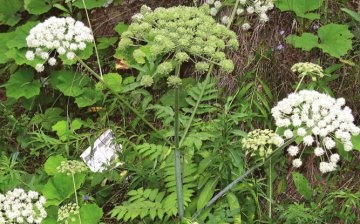Angelica officinalis
Angelica officinalis is an umbrella plant that can grow up to two meters in height. Its stem is round and hollow, and in the upper part it is sometimes furrowed. The leaves of this plant have large, highly expanding sheaths. He has greenish-white small flowers, which are collected in complex umbrellas and have 20-40 rays. Angelica blooms in July-August. The dried rhizome is used in folk medicine. After the root is peeled, it is cut lengthwise and hung to dry.
Angelica officinalis is found in northern Asia and northern Europe, as well as in Germany. This plant is often used in folk medicine.
The underground organs of angelica contain coumarins, essential oils and furocoumarins, terpenoids, tannins, and organic acids. The flavonoid diosmin is considered the most basic active ingredients of angelica, and coumarins in the form of ostrutol, bergapten, oxypeucedanin and other substances are considered in their fruits.
Angelica rhizome and roots are often used for gastrointestinal diseases in order to enhance the motor and secretory function of the intestines and reduce fermentation processes in them. Angelica can also provide a diuretic.
Angelica officinalis has antimicrobial, anti-inflammatory, analgesic, expectorant effect. A decoction and infusions of this plant are used for laryngitis, bronchitis, and also as a diaphoretic.
You can get dried angelica at a drugstore or specialty places that sell medicinal herbs. And if you are familiar with herbs, then try to prepare this plant yourself.



